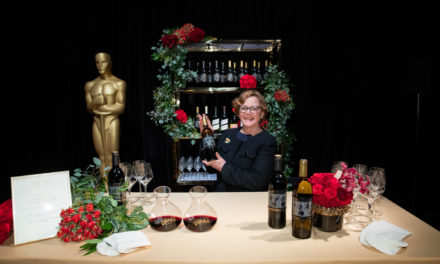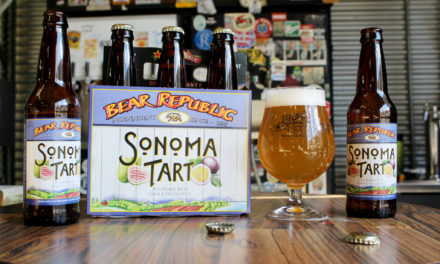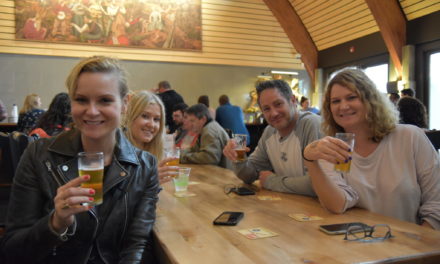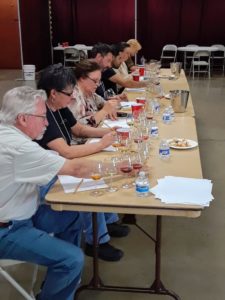 What makes a good cider? As in any beverage, it starts with quality ingredients, a good strategy, and the ability to keep things from going blatantly south in a hand basket. In short, the resulting beverage has to be like a gymnast: possessed of obvious balance and integrity of execution.
What makes a good cider? As in any beverage, it starts with quality ingredients, a good strategy, and the ability to keep things from going blatantly south in a hand basket. In short, the resulting beverage has to be like a gymnast: possessed of obvious balance and integrity of execution.
Thus, at the 5th annual California Cider Competition and 4th Annual Mendocino Apple Show International Cider Competition, managed by Debra del Fiorentino of Wine Competitions Management & Productions, my panel of four judges ventured down the yellow brick road of ciders in search of goodness, and perhaps, greatness.
Like Dorothy, we met some odd characters along the way—including scary flying monkeys, from which we barely escaped. We also got to peek behind the curtain, thanks to the fact that one of my panelmates, Dennis Yardroff, is an avid brewer and chef, and can recite the names and tendencies of every yeast known in brewerdom, complete with how they act out when allowed to run amok.
For example, brettanomyces (commonly called “brett”) is actually a beneficial organism when making certain beers and ciders, but it can be so disastrous in winemaking that, Yardroff explained, some winemakers won’t even set foot into a building where such beverages are being produced for fear of contamination.
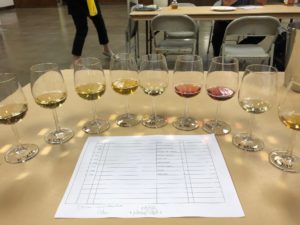
Categories and Vocabulary
As we tasted through the 30-some examples on our panel, which covered both commercial and non-commercial entries, along with California-produced ciders and those from outside the state, we learned about different cider styles.
Fine ciders (and perrys) come in six categories:
- Modern Cider
- Heritage Cider
- Traditional Cider
- Natural Cider
- Modern Perry (pear)
- Traditional Perry (pear)
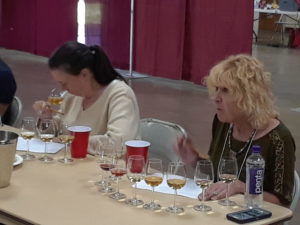 Flavored specialty ciders are also broken down into six different categories:
Flavored specialty ciders are also broken down into six different categories:
- Fruit Cider
- Hopped Cider
- Spiced Cider
- Wood-Aged Cider
- Specialty Cider and Perry
- Unlimited Cider and Perry
Intensified or distilled beverages can be entered in one of these categories:
- Ice Cider
- Fortified Cider
- Spirits
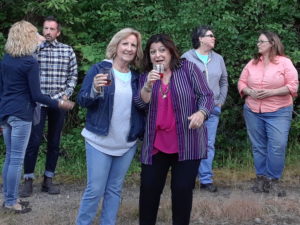 Modern ciders are generally made primarily from culinary or table apples, as opposed to apples cultivated strictly for cider. They’re generally lower in tannin and higher in acidity; they should be refreshing, as opposed to bland; and they should be neither too sweet nor too austere. Same goes for modern perry, which is made from what we call table pears.
Modern ciders are generally made primarily from culinary or table apples, as opposed to apples cultivated strictly for cider. They’re generally lower in tannin and higher in acidity; they should be refreshing, as opposed to bland; and they should be neither too sweet nor too austere. Same goes for modern perry, which is made from what we call table pears.
Varieties include Winesap, Macintosh, Golden Delicious, Braeburn and Jonathan are typical of Modern Cider apples. Multi-use varieties, like Northern Spy, Russets, Baldwin, crabapples, and suitable wildings (uncultivated wild apples, often from seed) may also be used.
Heritage ciders are made primarily from multi-use or cider-specific bittersweet/bittersharp apples, with wild or crab apples sometimes used for acidity/tannin balance. These ciders are higher in tannin than modern ciders and typically lack the malolactic fermentation (MLF) flavor notes of traditional ciders from England or France. Similarly, traditional perry is made from pears specifically cultivated for cider.
Traditional refers to the distinctive styles of English, French, or Spanish ciders, both made with bittersweet or bittersharp apple varieties.
French varieties for traditional ciders include Nehou, Muscadet de Dieppe, Reine des Pommes, and Michelin.
English varieties for traditional ciders include Kingston Black, Stoke Red, Dabinett, Porter’s Perfection, Nehou, Yarlington Mill, Major, and various Jerseys.
English ciders are typically fermented in neutral wood and go through malolactic for spicy, smoky, and barnyard character. They’re generally bone dry, often austere, just hinting of fruit and tannin, with a long complex finish. French ciders are typically fermented with salt or calcium compounds to aid pectin coagulation. They’re also generally sweetened to match the acidity and come across as sweet and full-bodied. Spanish cider (sidra) is still, dry, cloudy, and acidic. Some acetic acid is also a part of the traditional flavor profile, giving a piquant rather than sour or vinegary note; they’re always dry and tangy.
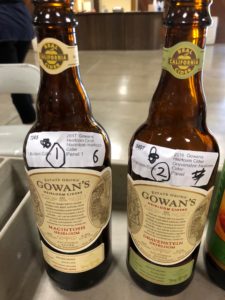 Cider Winners
Cider Winners
When all the entrants had been judged by the two panels, nine ciders rose to the top in a tasteoff for the overall sweepstakes win.
Winner of the California Commercial Cider Competition was Gowan’s 2016 Gravenstein Heirloom Cider, from Anderson Valley, Philo, Calif., in the Heritage class.
In the California Non-Commercial Cider Competition, the winner was 2018 Bruce Wilson Red Rum, Wood-Aged, Canoga Park, Calif.
In the International Commercial Competition, which saw entries from Michigan, Oregon, Washington, and North Carolina, among others, Boston Beer Company’s 2017 Angry Orchard Iceman Cider, entered in the Ice Cider category, was declared the winner.
In the Modern Commercial Cider class, Gowan’s 2016 Macintosh Cider took Best of Class, while Gowan’s Heirloom Cider, 1876 Heirloom Cuvee, Sparkling, Anderson Valley, won a Double Gold in the Traditional Commercial class. It’s made from more than a dozen heirloom varietals, some of which date back to 1876, when the Gowan family first planted apple trees in Philo. My panelmate, Traci Dutton said, “This is the cider we want to take to the prom!”
Drew Family’s 2016 “Sur la Mer” Brut Cider, Mendocino, Calif., also took a Double Gold in the Traditional Class. It’s made from a 60-year-old orchard three miles from the Pacific coast. My panel described it as having lovely apple and quince flavors with fennel notes, lively carbonation and a great finish.
We also loved the Santa Cruz Cider Company’s wood-aged Gravenstein cider, awarding it a Gold medal for its pleasing, slightly funky aromas and classic flavors of pure Gravenstein apple.
Common Cider from Oregon’s Blood Orange Cider, made a big impression. We described it as “floral, citrusy, and reminiscent of an Orange Julius.” We deemed its Hibiscus Saison, “Wonderfully elegant, exciting, and supremely balanced, with floral and berry aromas.” Both were entered in the Specialty category. We also gave a Gold medal to Common Cider’s Blackberry Sangria, in the Fruit Cider category, describing it as, “The Pinot Noir of ciders: wonderful, with layered complexity a multitude of berries and great legs!”
Drink up! There’s more than one way to get your apple a day.
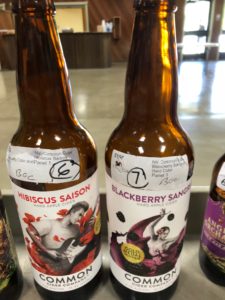 Competition Background
Competition Background
One of the founders of the California Cider Competition, Sharon Gowan of Gowan’s Heirloom Orchards in Philo, Calif., says the competition began five years ago to fill a perceived need for California ciders to gain market recognition. “At the time, there was just one competition in Michigan, and after talking with California cider makers, we thought that it would be great to have a competition with judges from the California market, for ciders made from California apples and pears,” she says.
Provenance is such an important part of any food or beverage experience: “People want to discover and support real California Ciders, and have that authentic connection with a real place, they like the idea of supporting farms and local food.” Because the California Cider Competition showcases the best ciders made with California fruit, it’s led to a program called Real California Cider certification, created by the California Cider Association. Thus far, four cideries have been certified.
When a number of cideries outside of California expressed interest in the competition, founders created the International Cider Competition, which is held concurrently. Both competitions are now managed by Debra Del Fiorentino, president and owner of Wine Competitions Management & Productions and Libation Logistics Inc.
Many of the entrants in this year’s competitions will be showcased at the upcoming Mendocino County Fair and Apple Show, which takes place at the Mendocino County Fairgrounds in Boonville on September 14-16, 2018.

























